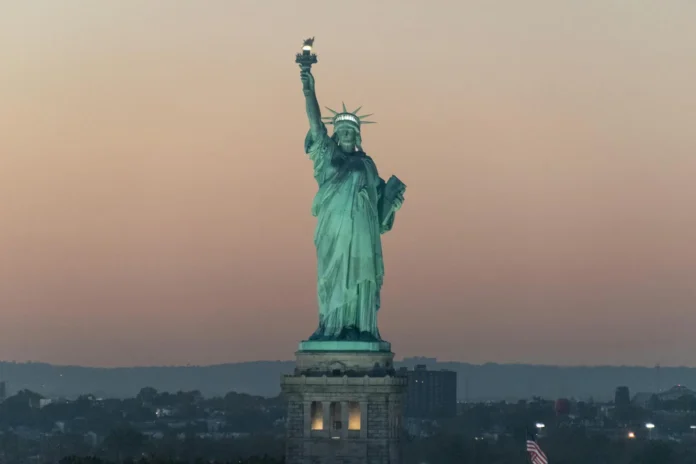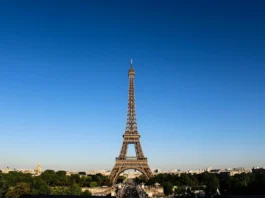“Where Liberty Enlightens the World“
Standing tall on Liberty Island in New York Harbor, the Statue of Liberty—affectionately known as Lady Liberty—has greeted millions of immigrants, tourists, and dreamers for over a century. With her torch raised high and her face turned toward the horizon, she embodies not only American ideals but also universal values of freedom, democracy, and human dignity. As one of the most iconic monuments in the world, the Statue of Liberty remains a symbol of hope to people across generations and nations.
The statue was a gift from the people of France to the United States, intended to commemorate the centennial of American independence and the enduring friendship between the two nations. Designed by French sculptor Frédéric Auguste Bartholdi and with engineering by Gustave Eiffel—the mind behind the Eiffel Tower—the statue was completed in France in 1884, disassembled, and shipped to the United States in 1885. After months of reassembly, it was officially unveiled on October 28, 1886 in a ceremony attended by President Grover Cleveland.
Lady Liberty stands at a total height of 305 feet (93 meters) from the ground to the tip of her torch. The statue alone is 151 feet tall and rests on a pedestal and star-shaped foundation that were funded largely by American citizens through grassroots campaigns. Built from copper sheets over a framework of iron and steel, her green hue—called patina—is the result of natural oxidation, which has protected the metal from corrosion over the years.
Her imagery is rich in symbolism. In her right hand, she holds a torch that represents enlightenment and guidance—a beacon leading the way to liberty. In her left hand, she clutches a tablet inscribed with the date July 4, 1776, marking the adoption of the U.S. Declaration of Independence. At her feet lie broken chains, representing the abolition of oppression and tyranny. Her seven-pointed crown symbolizes the seven continents and seven seas, signifying the universal concept of liberty.
Perhaps the most emotionally powerful role of the Statue of Liberty was as a welcoming figure to immigrants arriving in the United States during the late 19th and early 20th centuries. As ships crossed the Atlantic and entered New York Harbor, the sight of Lady Liberty was often the first glimpse of America for millions seeking a new life. Her image came to represent opportunity, safety, and the dream of a better future.
Adjacent to Liberty Island is Ellis Island, the federal immigration station that processed over 12 million immigrants between 1892 and 1954. For many, the journey from the Old World to the New was filled with hardship, uncertainty, and sacrifice. Seeing Lady Liberty rise on the horizon offered reassurance that they had reached a land where hope could be reborn.
This emotional connection was beautifully captured in the poem “The New Colossus” by Emma Lazarus, written in 1883 to help raise funds for the statue’s pedestal. Though not originally part of the monument, the poem was later engraved on a bronze plaque and mounted inside the pedestal in 1903. Its most famous lines have come to define the Statue’s message to the world:
“Give me your tired, your poor,
Your huddled masses yearning to breathe free,
The wretched refuse of your teeming shore.
Send these, the homeless, tempest-tost to me,
I lift my lamp beside the golden door!”
More than just an artistic marvel, the Statue of Liberty is a testament to collaboration and shared ideals. Its construction and symbolism unite elements of neoclassical architecture, Enlightenment philosophy, and 19th-century engineering. Its presence on an island accessible only by boat further enhances its aura as a beacon set apart, calling out to those searching for something greater than themselves.
Over the years, Lady Liberty has endured through wars, terrorist attacks, natural disasters, and political shifts. After the 9/11 attacks in 2001, Liberty Island was closed to the public for security reasons. The statue’s crown was not reopened until 2009. These events only deepened her significance as a resilient and steadfast symbol of endurance in the face of adversity.
In 1984, the Statue of Liberty was designated a UNESCO World Heritage Site, recognized for its cultural importance and enduring relevance. In preparation for her centennial in 1986, the statue underwent a major restoration effort, during which structural supports were updated, her torch was replaced, and her crown was made accessible once again. The celebration drew global attention and reaffirmed her place as a monument not only for the United States but for the world.
Today, Liberty Island attracts over 4 million visitors annually. Tourists can explore the Statue of Liberty Museum, which opened in 2019 and features immersive exhibits, historical artifacts, and a full-scale replica of the statue’s face and foot. For those willing to climb 354 steps to the crown, the experience offers panoramic views of New York Harbor and a deeper sense of connection with the statue’s legacy.
Lady Liberty has also become a powerful icon in popular culture, protest movements, and political discourse. She has appeared in films, literature, music, and art, often reinterpreted to reflect the evolving ideals of freedom, justice, and human rights. From civil rights marches to refugee advocacy campaigns, her torch has been held high not just by Americans, but by people around the globe who see her as a figure of solidarity and hope.
Despite the changing tides of history, the essence of the Statue of Liberty remains timeless. She represents not only the birth of a nation but also the aspiration of all people to live in freedom, with dignity and equality. In a world often divided by borders, conflicts, and ideologies, Lady Liberty reminds us of our shared humanity and the enduring promise of a better tomorrow.
In conclusion, the Statue of Liberty is more than a monument—it is a global symbol of freedom, refuge, and resilience. Whether seen from the deck of a ship, through a plane window, or from the bustling streets of New York City, her image stirs the soul and calls to our better angels. She remains one of the most profound testaments to the enduring human spirit—and a shining light for all who dare to dream.




